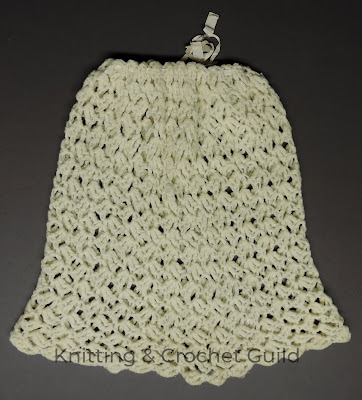 |
| Child's Crochet Petticoat |
This crocheted petticoat for a little girl was given to the Knitting & Crochet Guild in 2016. The donor had bought a chest of drawers in an Exeter antique centre, and found inside it several pieces of lace and the petticoat. Rather than throwing them out, she looked for suitable homes for both the lace and the crochet - the lace was offered to the Lace Guild, I believe.
The petticoat doesn't look very exciting: it is 15 inches (38 cm.) long, and simply constructed in thick wool, with an opening at the top and a ribbon threaded through the top edge as a drawstring.
 |
| Detail of Petticoat |
But it has a paper label sewn to it, saying that it was worked in 1910 by H.M. the Queen of England.
 |
| Petticoat label |
In May 1910 Edward VII died, George V came to the throne and his wife became Queen Mary. They had been living in Marlborough House (the address on the label) and stayed there until the end of the year - Queen Alexandra (Edward VII's widow) did not move from Buckingham Palace to Marlborough House until 1911. So I am confident the the Queen of England referred to on the label is Queen Mary. Besides which, the KCG collection already had an almost identical petticoat made by Queen Mary in 1921. (That one has been kept in a glass case, but is unfortunately badly discoloured). The 1921 petticoat was, according to its label, sold for charity, and we can guess that the 1910 petticoat was also made for charity.
There are newspaper records of Queen Mary making garments for charity in that year (1910). She was Patron of the London Needlework Guild, founded in 1882 to provide clothing for an orphanage, and later 'useful garments for the poor', distributed through hospitals and other institutions.
In April 1910, The Gentlewoman paper advertised for ladies willing to become Associates of its own Group of the London Needlework Guild, and said:
The object of the Guild is to distribute clothing, household linen, or any articles suitable for the sick and poor among the Hospitals, Nursing Institutions, Missions, Refuges, and Parishes in London. The only obligation undertaken by an Associate is to supply at least two useful articles every year, but they may send as many more as they choose.
Queen Mary's mother was the original Patron of the Guild, and she became Patron in turn after her mother's death in 1897. It was renamed Queen Mary's Needlework Guild (QMNG) on the outbreak of war in 1914. The Guild still exists, now as the Queen Mother's Clothing Guild.
Queen Mary was an active member, not just a figurehead, for many years. There was an exhibition each November of items collected during the year, usually reported in the newspapers. The 1910 exhibition was reported on by The Times newspaper:
“The work done during the last twelve months by the members of the London Needlework Guild, which has the Queen for its patroness, will be on view at the Imperial Institute, South Kensington, to-day. …. Neatly stacked in carefully classified piles ….are 54,050 garments - the largest number sent in for many years. Of this total the Queen, who spent two days at the Imperial Institute supervising the classification and arrangement of the garments, is responsible for the collection of 15,333 garments, this being more than 2,000 in excess of her contribution last year.
Among the contributors to the Queen's group were the King, who presented 1,000 garments, Princess Mary, who gave 700, the Prince of Wales and his younger brothers, the Princes Albert, Henry, and George. Many of the garments included in the group has been made by the donors. The Queen had knitted several little woollen petticoats. Princess Mary had made three woollen baby's hoods, and the young Princes, with the aid of knitting frames, had made a number of warm woollen scarves and comforters."
However, the Sheffield Telegraph, reporting on the same exhibition, describes “some very pretty crochet wool petticoats, Her Majesty’s own work.” Probably The Times reporter did not know the difference between knitting and crochet. (I imagine that the garments provided by the King were bought in. A report on the Guild exhibition in another year says that his contribution was men’s flannel shirts, which he would not have made himself.)
We don't know for certain if our petticoat is one of the garments made for the Guild, but it was almost certainly made to the same pattern. If it was indeed made for the LNG, how it came to be kept, unworn, is a puzzle. It should have been distributed with the other garments in the exhibition, and given to some child who needed a warm petticoat.
Perhaps someone decided that it was more valuable as a piece of Royal handiwork than as a useful garment? Or perhaps it was made to be sold for some other charity, like the 1921 petticoat? But in either case, it has been kept in good condition because of its label.
Apart from its royal origin, it is a very ordinary garment that would not normally have survived. If it had been given to a poor child as probably intended by the Queen, it would have been worn every day and passed on to a succession of other children until it wore out. It makes a striking contrast with the Irish crochet from the same period which has survived because it was expensive, and so was carefully looked after. And it is ironic that it is valuable today as a rare example of a very mundane garment, as much as for the fact that it was made by Queen Mary.